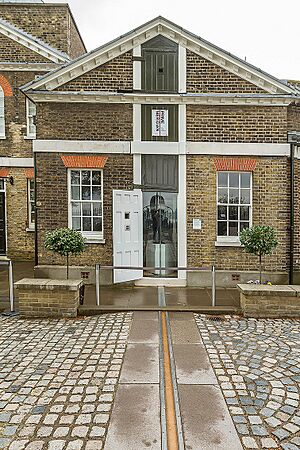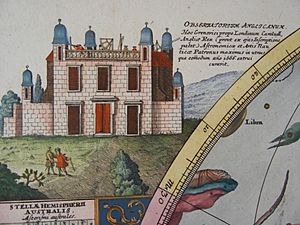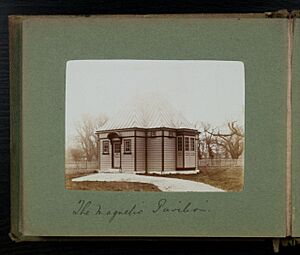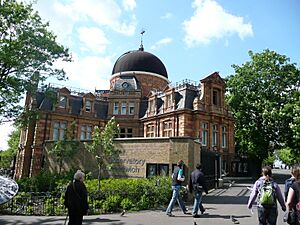Royal Observatory, Greenwich facts for kids
| Location | Greenwich, London, England |
|---|
The Royal Observatory, Greenwich (often called ROG) is a famous building on a hill in Greenwich Park in south east London. It looks out over the River Thames. This observatory played a huge part in the history of astronomy (the study of stars and planets) and navigation (finding your way). It's also where the Prime Meridian line passes through, which is why Greenwich Mean Time (GMT) got its name. GMT was a very important way to tell time all over the world. Today, we use something similar called Coordinated Universal Time (UTC). The Royal Observatory, Greenwich, is part of a group of museums called Royal Museums Greenwich.
King Charles II ordered the observatory to be built in 1675. The first stone was laid on August 10. Sir Christopher Wren, a famous architect, chose the spot. It was the old site of Greenwich Castle in Greenwich Park, which was already royal land. At the same time, the King created the job of Astronomer Royal. This person would lead the observatory and work hard to map the stars. The goal was to help sailors find their exact location at sea. John Flamsteed became the first Astronomer Royal. The building was finished in the summer of 1676 and was often called "Flamsteed House" after him.
Over time, the scientific work of the observatory moved to other places. Today, the Greenwich site is mostly a museum. However, a new telescope called the AMAT telescope started working there for research in 2018.
Contents
History of the Observatory
Key Moments in Time
- 1675: King Charles II officially started the Royal Observatory on June 22.
- 1675: Construction began on August 10.
- 1714: The Longitude Act was passed. This law created the Board of Longitude to find ways to measure longitude at sea. The Astronomer Royal was always part of this board.
- 1767: The fifth Astronomer Royal, Nevil Maskelyne, started publishing The Nautical Almanac. This book helped sailors navigate using observations from the Observatory.
- 1818: The Royal Observatory became part of the Navy's care. It was then in charge of looking after the Navy's marine chronometers (very accurate clocks for ships).
- 1833: Daily time signals began with the dropping of a time ball.
- 1852: Time signals started being sent through telegraph lines.
- 1884: The International Meridian Conference in Washington D.C. decided that the Greenwich Prime Meridian would be the world's main meridian. It stayed this way for 100 years.
- 1893: The large 28-inch Great Refractor telescope was installed.
- 1924: Hourly time signals (Greenwich Time Signal) from the Royal Observatory were first broadcast on February 5.
- 1948: The Astronomer Royal's office moved to Herstmonceux in East Sussex.
- 1957: The Royal Observatory finished moving to Herstmonceux. The Greenwich site was then called the Old Royal Observatory.
- 1984: The IERS Reference Meridian became the new Prime Meridian for the world. It is very close to the old Greenwich Meridian, but about 102 meters (335 feet) east of it.
- 1990: The Royal Greenwich Observatory (RGO) moved to Cambridge.
- 1998: The RGO officially closed. The Greenwich site went back to its original name, the Royal Observatory, Greenwich. It became part of the National Maritime Museum.
- 2011: The museums in Greenwich, including the ROG, became known as the Royal Museums Greenwich.
The Observatory's Location
This land has had important buildings on it for a very long time. Greenwich Palace, where the Maritime Museum is now, was where King Henry VIII and his daughters Mary I and Elizabeth I were born. The Tudors used Greenwich Castle, which stood on the hill where the Observatory is now, as a hunting lodge.
In 1676, the main building of the observatory, now called Flamsteed House, was finished on Greenwich hill.
How it was Built
The idea for a Royal Observatory came from Sir Jonas Moore in 1674. He convinced King Charles II to create it, with John Flamsteed as its leader. The Ordnance Office was in charge of building it. Sir Jonas Moore even paid for the main instruments himself. Flamsteed House was designed by Sir Christopher Wren, possibly with help from Robert Hooke. It was the first building in Britain made just for scientific research. It cost £520, which was a lot of money back then. It was built on the old foundations of a tower, which meant it was slightly off true North.
Moore gave two clocks, made by Thomas Tompion, for the Octagon Room. This was the main room in the building. These clocks were special because their pendulums were very long, about 13 feet (4 meters). This made them incredibly accurate for their time, only losing about seven seconds a day.
The first observatory was home to the Astronomer Royal, his assistant, and their families. It also held the scientific tools Flamsteed used to map the stars. Over time, the observatory grew. It worked with government groups like the Board of Longitude. It also had a Board of Visitors, made up of important scientists. By the late 1700s, it did many more things. This included publishing the Nautical Almanac, advising the government, sending out time signals, and studying weather and magnetism. The site and staff grew as well.
Mapping Stars
When the observatory started in 1675, the best star maps were not very accurate. One of Flamsteed's first jobs was to create much better maps. These new maps would help sailors find their longitude.
Another important map was made by Astronomer Royal James Bradley. Between 1750 and 1762, he mapped 60,000 stars. His maps were so good that they were still used in the 1940s!
In the early 1800s, the main tools for mapping stars were not ideal. But when George Biddell Airy became Astronomer Royal in 1835, he wanted better instruments. He had a special telescope called a transit circle installed in 1851. This telescope was used for 100 years to map stars.
Mapping stars accurately is tricky. Scientists have to account for how light bends when it passes through Earth's air. They also have to correct for tiny wobbles in Earth's spin. The transit circle measures two things: the time a star crosses a certain line in the sky, and its height above the horizon. This helps scientists map stars or, if they have an accurate star map, tell the exact time.
The Greenwich Meridian

British astronomers have always used the Royal Observatory as a starting point for measurements. Several different meridians (imaginary lines from North to South Pole) have passed through its buildings. The most famous one, the Prime Meridian, goes through the Airy transit circle telescope. This line was chosen as the world's Prime Meridian at a meeting in Washington, DC, on October 22, 1884. From then on, countries all over the world used it for their maps and timekeeping.
Today, a brass (now stainless steel) strip marks the Prime Meridian in the Observatory's courtyard. Since 1999, a powerful green laser beam shines north from the observatory at night, showing the line.
The old astronomical Prime Meridian has been replaced by a more precise one today. This new line, called the IERS Reference Meridian, is about 102.5 meters (336 feet) east of the old Greenwich line. This change happened because modern mapping uses a single, more accurate model of the Earth.
Greenwich Mean Time (GMT)

A very important tool for telling time was the Airy Transit Circle (ATC). It was used from 1851 to 1938. It was decided that the "meridian line marked by the cross-hairs in the Airy Transit Circle eyepiece would indicate 0° longitude and the start of the Universal Day." This meant that when a known star crossed that line in the telescope, it marked a specific time.
By 1925, there was some confusion about whether GMT started at noon or midnight. So, in 1928, scientists decided to use Universal Time (UT) instead of GMT for astronomy. In 1957, the observatory stopped measuring time.
The name "GMT" is still used a lot, especially in the UK. However, today's official time, Coordinated Universal Time (UTC), is based on very accurate atomic clocks and modern measurements of Earth's rotation.
The Greenwich Time Ball

The red time ball at Greenwich was put up in 1833. It was a public signal for time. The ball usually sits low. At 12:55 PM, it starts to rise. By 12:58 PM, it reaches the top. Then, at exactly 1:00 PM, the ball drops.
This time ball helped sailors on the River Thames and others nearby set their clocks to GMT. The Astronomer Royal John Pond had it installed. At first, someone dropped it by hand. From 1852, it dropped automatically using an electric signal from a special clock. The ball still drops every day at 1:00 PM.
The first time ball was made of wood and leather. It cost £180. It was lifted by a rope from the Octagon room. People could see the ball drop from far away to set their clocks. It was very popular with the public, sailors, and clock makers.
The reason 12 noon was not chosen for the drop was because astronomers were busy recording when the Sun crossed the meridian at that time. Sometimes, if it was too icy, snowy, or windy, the ball would not drop. In 1852, they also started sending time signals through telegraph wires.
The 1890s at the Observatory
The 1890s saw a new, bigger telescope added: the 28-inch Grubb Refractor. Because this new telescope was longer, a larger dome was needed. This led to the famous "onion dome" shape that is wider than the building below it. The original dome was made of paper-mâché and iron. For the observatory's 300th anniversary, it was replaced with a new dome made of fiberglass.
The telescope was installed by 1893. Its 28-inch glass lens was made by Grubb.
An attempted bombing happened near the Observatory on February 15, 1894. A 26-year-old French anarchist named Martial Bourdin accidentally set off a bomb in Greenwich Park. He died shortly after. It's not known why he chose the observatory.
Moving the Observatory
For much of the 1900s, the Royal Greenwich Observatory was not in Greenwich. It moved to Herstmonceux in East Sussex in 1957. By 1924, some departments had already moved. For example, the Magnetic and Meteorological Departments moved to Abinger in Surrey. This was because electric trains in Greenwich were affecting their measurements.
During World War II (1939-1945), many parts of the observatory were moved away from London to avoid German bombs. On October 15, 1940, during the Blitz, a bomb hit the courtyard gates. The wall above the Gate Clock fell, and the clock was damaged. It was repaired after the war.
The Royal Observatory at Herstmonceux

After World War II, in 1947, it was decided to move the Royal Observatory to Herstmonceux Castle. This was because of too much light pollution in London. The new site was about 70 kilometers (43 miles) south-east of Greenwich. The observatory was officially called the Royal Greenwich Observatory, Herstmonceux. The Astronomer Royal moved there in 1948, but the scientists didn't move until the new buildings were ready in 1957.
The largest telescope from Greenwich, the 36-inch Yapp telescope, was moved to Herstmonceux in 1958. It was used for astronomy there for many years.
On December 1, 1967, the Isaac Newton Telescope was opened by Queen Elizabeth II at Herstmonceux. It was the biggest telescope in the British Isles. But because the weather was often cloudy, it was moved to a better location in the Canary Islands in 1979. In 1990, the RGO moved again to Cambridge.
At Herstmonceux, the castle grounds are now home to a study center and The Observatory Science Centre. This science center opened in 1995. Some of the old telescopes are still there and are used for public viewing events. It's a popular place for tourists and education.
The Royal Observatory at Cambridge
In 1990, the Royal Observatory moved from Herstmonceux to Cambridge. It was next to the University's Institute of Astronomy. By this time, the RGO's main job was to help British scientists use powerful telescopes in places like the Canary Islands and Hawaii.
In 1998, the RGO was closed as an institution. Some of its work moved to other places. The old observatory site at Greenwich went back to its original name, the Royal Observatory, Greenwich. It became part of the National Maritime Museum.
Greenwich Site Returns to Active Use
In 2018, the Annie Maunder Astrographic Telescope (AMAT) was installed at the ROG in Greenwich. AMAT is a group of four telescopes used for astronomical research. It started working in June 2018 and includes:
- A 14-inch telescope that takes clear pictures of the Sun, Moon, and planets.
- A telescope made just for observing the Sun.
- A telescope with special filters to see distant nebulae (clouds of gas and dust in space).
- A general-purpose telescope.
These telescopes and the work to set them up cost about £150,000. They were paid for by grants, museum members, and public donations. The telescopes are in the Altazimuth Pavilion and are controlled by a computer.
Magnetic Observations
The first magnetic measurement at the observatory was taken in 1680 by John Flamsteed. Later, other Astronomers Royal also took magnetic measurements.
In the 1800s, George Airy created the Magnetical and Meteorological Department. The first Magnetic House was built near the observatory. But by 1900, a second one was built further away to avoid magnetic interference. Both buildings were made of materials that were not magnetic.
Observatory Museum
The observatory buildings in Greenwich are now a museum. It shows tools used for astronomy and navigation. You can see John Harrison's amazing clocks, called H4, which helped sailors find their longitude. You can also see his three earlier clocks. The museum has many other old clocks and instruments. These show how people learned to tell time very accurately for sailing and studying the stars.
The museum also has the 28-inch Grubb refracting telescope from 1893. This is the largest of its kind in the UK. The Shepherd Gate Clock outside the observatory gate is an early example of an electric clock.
In 2005, the museum started a big project to add a new planetarium and more display areas. The Royal Observatory, Greenwich, reopened in 2007 with the new 120-seat Peter Harrison Planetarium. The museum is very popular, with millions of visitors each year.
Images for kids
-
The centuries-old Flamsteed House overlooking Greenwich Park in London. The statue at left is of Major General James Wolfe.
-
Aerial view of the Royal Greenwich Observatory, Herstmonceux site in East Sussex. The dome on the right used to hold the Isaac Newton Telescope.
-
Laser projected from the observatory marking the Greenwich Prime Meridian line (1999).
-
The Queen's House (center left) at Greenwich, with the Royal Observatory on the skyline behind (2017).
-
Imperial standard lengths on the wall of the Royal Observatory, Greenwich, London.
-
Dome of the Great Equatorial Building overlooking Greenwich Park.
See also
 In Spanish: Real Observatorio de Greenwich para niños
In Spanish: Real Observatorio de Greenwich para niños
- List of astronomical observatories


















